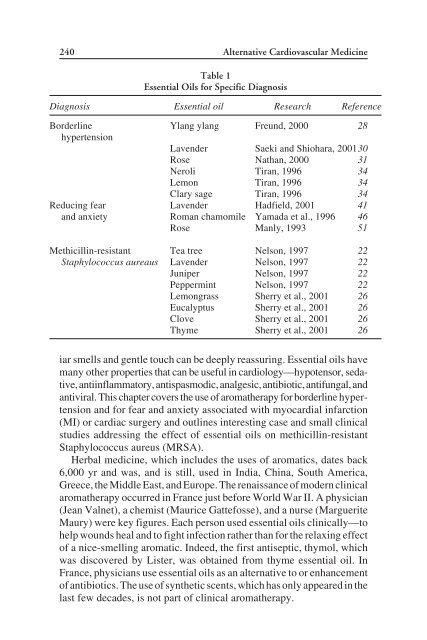Complementary Alternative Cardiovascular Medicine
Complementary Alternative Cardiovascular Medicine
Complementary Alternative Cardiovascular Medicine
You also want an ePaper? Increase the reach of your titles
YUMPU automatically turns print PDFs into web optimized ePapers that Google loves.
240 <strong>Alternative</strong> <strong>Cardiovascular</strong> <strong>Medicine</strong><br />
Table 1<br />
Essential Oils for Specific Diagnosis<br />
Diagnosis Essential oil Research Reference<br />
Borderline Ylang ylang Freund, 2000 28<br />
hypertension<br />
Lavender Saeki and Shiohara, 200130<br />
Rose Nathan, 2000 31<br />
Neroli Tiran, 1996 34<br />
Lemon Tiran, 1996 34<br />
Clary sage Tiran, 1996 34<br />
Reducing fear Lavender Hadfield, 2001 41<br />
and anxiety Roman chamomile Yamada et al., 1996 46<br />
Rose Manly, 1993 51<br />
Methicillin-resistant Tea tree Nelson, 1997 22<br />
Staphylococcus aureaus Lavender Nelson, 1997 22<br />
Juniper Nelson, 1997 22<br />
Peppermint Nelson, 1997 22<br />
Lemongrass Sherry et al., 2001 26<br />
Eucalyptus Sherry et al., 2001 26<br />
Clove Sherry et al., 2001 26<br />
Thyme Sherry et al., 2001 26<br />
iar smells and gentle touch can be deeply reassuring. Essential oils have<br />
many other properties that can be useful in cardiology—hypotensor, sedative,<br />
antiinflammatory, antispasmodic, analgesic, antibiotic, antifungal, and<br />
antiviral. This chapter covers the use of aromatherapy for borderline hypertension<br />
and for fear and anxiety associated with myocardial infarction<br />
(MI) or cardiac surgery and outlines interesting case and small clinical<br />
studies addressing the effect of essential oils on methicillin-resistant<br />
Staphylococcus aureus (MRSA).<br />
Herbal medicine, which includes the uses of aromatics, dates back<br />
6,000 yr and was, and is still, used in India, China, South America,<br />
Greece, the Middle East, and Europe. The renaissance of modern clinical<br />
aromatherapy occurred in France just before World War II. A physician<br />
(Jean Valnet), a chemist (Maurice Gattefosse), and a nurse (Marguerite<br />
Maury) were key figures. Each person used essential oils clinically—to<br />
help wounds heal and to fight infection rather than for the relaxing effect<br />
of a nice-smelling aromatic. Indeed, the first antiseptic, thymol, which<br />
was discovered by Lister, was obtained from thyme essential oil. In<br />
France, physicians use essential oils as an alternative to or enhancement<br />
of antibiotics. The use of synthetic scents, which has only appeared in the<br />
last few decades, is not part of clinical aromatherapy.


